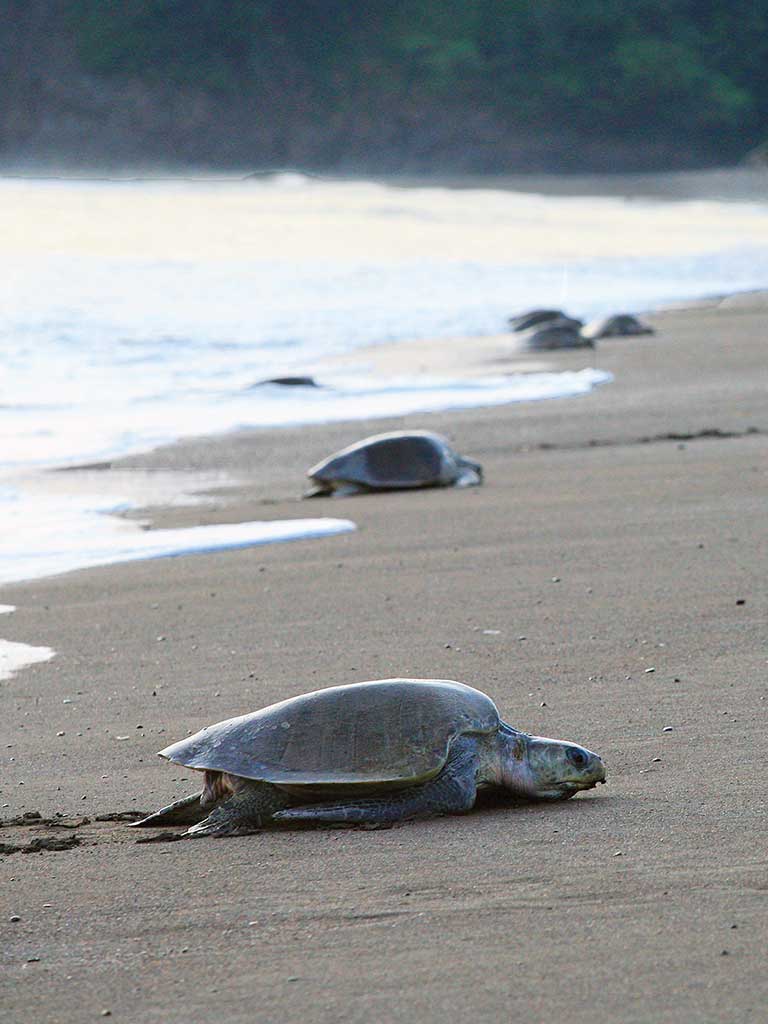Five of the world’s seven species of marine turtles nest on Costa Rica’s beaches, and you can see turtles laying eggs somewhere in Costa Rica virtually any time of year.
When near nesting sites, respect the turtles’ need for peace and quiet. Nesting turtles are very timid and extremely sensitive to flashlights, sudden movements, and noise.Parque Nacional Tortuguero, in northeastern Costa Rica, is one of fewer than 30 places in the world that the green turtle considers clean enough and safe enough to lay its eggs. Although green turtles were once abundant throughout the Caribbean, today there are only three major sites in the region where they nest: one on Aves Island, 62 kilometers (39 miles) west of Montserrat; a second at Gandoca-Manzanillo; and the third on the endless beach between Tortuguero and Pacuare, also the most important nesting site for leatherback turtles in Costa Rica.
Turtle hatchery at Refugio de Vida Silvestre Playa Hermosa y Punta Mala. Photo © Christopher P. Baker.
On the Pacific coast, the most spectacular nestings are at Playa Nancite in Parque Nacional Santa Rosa, Refugio Nacional de Vida Silvestre Ostional, and recently at Playa Camaronal, where tens of thousands of olive ridley turtles (lora) come ashore July-December in synchronized mass nestings known as arribadas. Giant leatherback turtles (baula) nest at Playa Grande, near Tamarindo, October-April and in lesser numbers at several other beaches. Hawksbills, ridleys, leatherbacks, Pacific greens, and occasionally loggerheads (primarily Caribbean nesters) appear in lesser numbers at other beaches along the Pacific coast.
Most of the important nesting sites in Costa Rica are now protected, and access to some is restricted. Turtle populations continue to decline because of illegal harvesting and environmental pressure, and all species are now critically endangered. Despite legislation outlawing the taking of turtle eggs or disturbing nesting turtles, nest sites continue to be raided by humans, encouraged by an ancient Mayan legend that says the eggs are aphrodisiacs. Mother Nature poses her own challenges: Coatis, dogs, raccoons, and peccaries dig up nest sites to get at the tasty eggs. Gulls and vultures pace the beach hungrily awaiting the hatchlings; crabs lie in wait for the tardy; and hungry jacks, barracudas, and sharks come close to shore for the feast. Of the hundreds of eggs laid by a female in one season, only a handful will survive to reach maturity.
Turtles have hit on a formula for outwitting their predators, or at least for surviving despite them. Each female turtle normally comes ashore two to six times each season and lays an average of 100 eggs on each occasion.
Most females make their clumsy climb up the beach and lay their eggs under the cover and cool of darkness (loggerheads and ridleys often nest in the daytime). They normally time their arrival to coincide with high tide, when they do not have to drag themselves puffing and panting across a wide expanse of beach. Some turtles even die of heart attacks brought on by the exertions of digging and laying.

Ridley turtles during an arribada at Playa Camaronal. Photo © Christopher P. Baker.
Once she settles on a comfortable spot above the high-tide mark, the female scoops out a large body pit with her front flippers. Then her dexterous hind flippers go to work hollowing out a small egg chamber below her tail and into which white, spongy, golf ball-size spheres fall every few seconds. After shoveling the sand back into place and flinging sand wildly around to hide her precious treasure, she makes her way back to sea.
The eggs normally take six to eight weeks to hatch, incubated by the warm sand. Some marvelous internal clock arranges for most eggs to hatch at night when hatchlings can make their frantic rush for the sea concealed by darkness. Often, baby turtles will emerge from the eggs during the day and wait beneath the surface of the beach until nightfall. They are programmed to travel fast across the beach to escape hungry mouths. Even after reaching the sea they continue to swim frantically for several days—flippers paddling furiously—like clockwork toys. No one knows where baby turtles go. They swim off and generally are not seen again until they appear years later as adults.
Turtles are great travelers capable of amazing feats of navigation. Greens, for example, navigate across up to 2,400 kilometers (1,500 miles) of open sea to return, like salmon, to the same nest site, guided presumably by stars and currents and their own internal compass.
When near nesting sites, respect the turtles’ need for peace and quiet. Nesting turtles are very timid and extremely sensitive to flashlights, sudden movements, and noise, which will send a female turtle in hasty retreat to the sea without laying her eggs. Sometimes she will drop her eggs on the sand in desperation, without digging a proper nest.
Freshwater turtles (jicoteas) are also common in Costa Rica, particularly in the Caribbean lowlands, where they are easy to spot basking on logs.
Excerpted from the Tenth Edition of Moon Costa Rica.